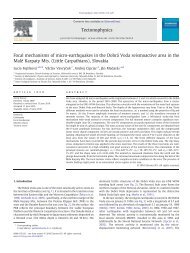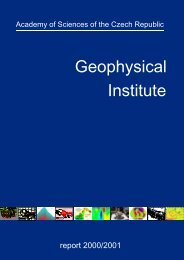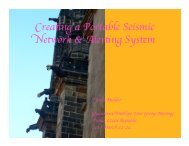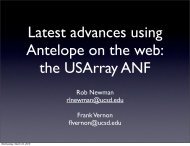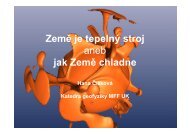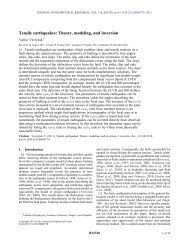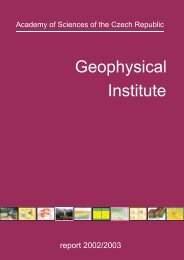Geophysical Institute of the ASCR
Geophysical Institute of the ASCR
Geophysical Institute of the ASCR
You also want an ePaper? Increase the reach of your titles
YUMPU automatically turns print PDFs into web optimized ePapers that Google loves.
Comparison <strong>of</strong> syn<strong>the</strong>tics calculated by <strong>the</strong> QI approximation <strong>of</strong> <strong>the</strong><br />
coupling ray <strong>the</strong>ory and by <strong>the</strong> Fourier pseudospectral method<br />
A possible test <strong>of</strong> accuracy <strong>of</strong> an approximate method is comparison <strong>of</strong> its results with results <strong>of</strong><br />
a more accurate method on models, at which both methods are applicable. The approximate method in<br />
our case is <strong>the</strong> quasi-isotropic (QI) approximation, see Pšenčík and Dellinger (2001) <strong>of</strong> <strong>the</strong> coupling<br />
ray <strong>the</strong>ory (see, e.g., Bulant et al., 2004). The QI approximation was designed to study S-wave<br />
propagating in inhomogeneous weakly anisotropic media, in which nei<strong>the</strong>r <strong>the</strong> ray <strong>the</strong>ory for isotropic<br />
media nor <strong>the</strong> ray <strong>the</strong>ory for anisotropic media work properly. The QI approximation is also expected<br />
to work in directions, in which S-wave phase velocities are close to each o<strong>the</strong>r, it is in singular<br />
directions <strong>of</strong> S waves and in <strong>the</strong>ir vicinities. In <strong>the</strong>se directions, <strong>the</strong> standard ray <strong>the</strong>ory fails. The<br />
Fourier method is assumed to be <strong>the</strong> more accurate method. It does not suffer from limitations <strong>of</strong> <strong>the</strong><br />
ray methods. It can be, for example, applied, in singular directions <strong>of</strong> S waves.<br />
Fig. 30. Comparison <strong>of</strong> QI (red) and Fourier (black) seismograms generated by a vertical point force in a VSP<br />
experiment in a vertically inhomogeneous HTI model with <strong>the</strong> axis <strong>of</strong> symmetry deviating from <strong>the</strong> vertical plane<br />
containing <strong>the</strong> source and <strong>the</strong> borehole.<br />
45




